|
Great Inventors in Electrical History
|
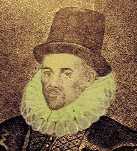 William Gilbert (1544 - 1603)
William Gilbert (1544 - 1603)
A natural philosopher known for his investigations of magnetism and
static electricity. He was the originator of the term "electricity"
as well. Many people regard Gilbert as the father of Electrical
Engineering. His primary work was in studying the earth's magnetism,
and from this he discovered that a compass' needle was attracted by
this magnetism, and not from the North Star - as was previously
believed. He also experimented in generating static electricity
using amber (a fossilized resin). |
 Otto von Guericke (1602 - 1686)
Otto von Guericke (1602 - 1686)
Documentation of his works in electricity were not well recorded, and as a result much is
unknown about his full contribution to this science. It is
acknowledged however, that he invented the first electrostatic
generator called the "Elektrisiermaschine". This is a significant
step forward, for that time period, towards our use of electricity
today. |
Francis Hauksbee (1666 - 1713) no image available
An eighteenth-century British scientist, and a member of the Royal Society.
He is best known for his work on Electricity and electrostatic repulsion.
Hauksbee discovered that if he placed a small amount of mercury in
the glass of his modified version of Otto von Guericke's
electrostatic generator and evacuated the air from it, and then
caused a charge to be built up on the ball, a glow was visible if he
placed his hand on the outside of the ball. This glow was bright
enough to read by, and later became the basis of Neon and high
intensity discharge lighting. At the time it would have looked
something like the plasma ball in the logo of this website. |
 Emilie du Chatelet (1706 - 1749)
Emilie du Chatelet (1706 - 1749)
A French mathematician, physicist, and author. She derived from Newton's work,
"Principia Mathematica", the notion of conservation of energy. Part
of this was the understanding that the kinetic energy of a moving object was
equal to the mass of the object times the square of it's velocity or
MV². Albert Einstein took this further with his equation E=MC² which
described the relationship between energy and matter, and how one
can be converted to the other. Du Chatelet also studied heat or
thermal energy, and how it is transmitted as light energy which we
know today as infrared energy. Her scientific work was not directly
related to electricity, but was so significant to understanding
energy for its time that we thought she deserved a place with these
other pioneers. |
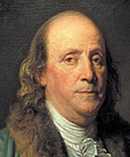 Benjamin Franklin (1706 - 1790)
Benjamin Franklin (1706 - 1790)
Franklin's most famous electric experiment was his kite experiment in which
he discovered that lightning was a form of electricity. Whether through
knowledge or luck, evidence shows that Franklin was insulated during this
experiment. Several others who attempted to repeat this experiment
were horribly electrocuted. He followed up on this discovery
with the invention of the lightning rod which safely diverted
lightning strikes on a building to an earth grounding electrode.
These strikes were a common cause of fire for large buildings, and
his invention was so effective and appreciated that Franklin
received the Royal Society's Copley Medal in 1753. He also
experimented with the collection of electrical charges using various
devices, and coined the labels for these charges "negative" and
"positive" to describe them. |
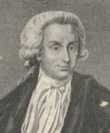 Luigi Galvani (1737 - 1798)
Luigi Galvani (1737 - 1798)
An Italian physician and physicist who discovered that muscle and nerve cells
produce electricity. During an experiment he touched the sciatic nerve in
the leg of a dead frog with a scalpel that had accidentally
collected a static charge. He observed that the frog's leg kicked as
if it were still alive. Through this he was able to conclude that
electricity was part of the biological animation process, or life
itself (Doctor Frankenstein?). Further investigations by him helped
lead the way towards development of the battery. Though he did not
invent the process, "galvanizing" - a plating process to reduce the
oxidation of metal - is named after him. |
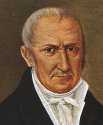 Alessandro Volta (1745 - 1827)
Alessandro Volta (1745 - 1827)
Alessandro Volta was a man with a true passion for electricity. While a young student
in school he wrote a poem in Latin on this fascinating new subject. In 1775 he
devised the electrophorus with Johannes Wilcke. This was a
single-plate capacitor used to produce imbalances of electric charge
through the process of electrostatic induction. He also devised
experiments such as the ignition of gases by an electric spark in a
closed vessel - much like a spark plug in an internal combustion
engine. Further work led up to the development of the voltaic pile,
a forerunner of the electric battery. He also determined that the
most effective pair of dissimilar metals to produce electricity was
zinc and silver. The term "volt" is derived from his name because of
work. A volt is a measurement unit of electrical potential or
electromotive force. |
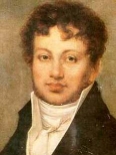 André Marie Ampère (1775 - 1836)
André Marie Ampère (1775 - 1836)
A French physicist and professor of mathematics. He is best known for his advancements in
the science of electromagnetism, and for establishing a measurable
relationship between magnetic fields and electricity. The term
"ampere" or "amp" is named after him. This is a unit of measurement
of electrical current flow in a conductor or circuit. |
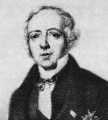 Hans Christian Oersted (1777 - 1851)
Hans Christian Oersted (1777 - 1851)
A Danish physicist and chemist also known for advancing the science of
electromagnetism. His most significant contribution in this area was the discovery
that a magnetic field radiates from a wire or conductor through
which there is a flow of electrical current. This principle is
behind the operation of clamp-on ammeters, widely used by
electricians today, which can measure the current flow through a
wire or conductor simply by clamping the "jaws" of the instrument
around it. A unit of magnetic induction called the "oersted" is
named after him, however it is not commonly used today outside of
electrical engineering studies. |
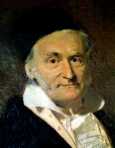 Carl Friedrich Gauss (1777 - 1855)
Carl Friedrich Gauss (1777 - 1855)
A German mathematician and scientist of profound genius who contributed significantly
to many fields; including number theory, analysis, differential geometry,
geodesy, magnetism, astronomy and optics. In electrical engineering
the gauss, abbreviated as G, is a unit of magnetic flux density or
magnetic induction. Many television sets that use a large cathode
ray tube employ an automatic degaussing electromagnet. This produces
a noticeable but brief hum when these televisions are first turned
on, and is designed to prevent image distortion which would be
caused by residual magnetism surrounding the picture tube. |
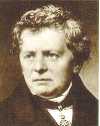 Georg Simon Ohm (1789 - 1854)
Georg Simon Ohm (1789 - 1854)
A German born physicist and mathematician. He is best known for using Volta's
invention of the early battery, or electrochemical cell as it was known then, to
determine the relationship between electrical current, voltage, and
resistance of the conductor in the circuit. This is known today as
Ohm's Law (I=V/R), where I represents the current flow, V represents
voltage, and R represents the resistance of the conductor making up
the circuit. He also discovered, because of his precise
measurement style, that the current flow through a wire is directly
proportional to its cross sectional area and inversely proportional
to its length. This is the basis for determining the resistance of
electrical conductors, and a "must know" if you're a modern day
electrician. It should be noted that the goal of superconductor
technology is to eliminate this resistance and take this factor out
of the equation. As with many brilliant minds who are ahead of
their time, Ohm did not receive favorable recognition for his
discoveries during most of his life. Most of his peers then simply
could not comprehend his work, probably in large part because of his
enigmatic manner. In 1841 however, he was recognized by the Royal
Society in London and awarded the Copley medal for his work. |
 Michael Faraday (1791 - 1867)
Michael Faraday (1791 - 1867)
A British chemist and physicist. His main contributions were in the fields of
electromagnetism and electrochemistry. The most recognizable legacy
from Faraday is the "farad" which is a unit of measurement of
capacitance. His work with electromagnetism was probably more
significant however. Building on earlier research, he discovered
that a magnet passing through a coil of wire would cause a current
to flow through the wire. From this discovery he went on to
construct an electric dynamo - the predecessor of the modern
generator. Faraday's Law of induction states that a magnetic field
changing in time creates a proportional electromotive force, and is
the principle behind which this dynamo, and modern generators
operate. This law subsequently became one of the four Maxwell
equations. In addition to this he discovered that the plane of
polarized light can be rotated by a strong magnetic field (called
the Faraday effect), and that a conducting enclosure can be used to
shield its interior against electric fields and electromagnetic
radiation (called a Faraday cage). An automobile can act as a
Faraday cage during a lightning storm, and is why it is safer to be
inside a car during such a storm. It is not due to the rubber tires
- as many believe - since that 6" or so gap to ground would do
little to stop a lightning bolt already traveling miles through the
sky. |
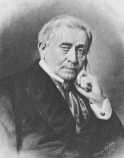 Joseph Henry (1797 - 1878)
Joseph Henry (1797 - 1878)
A Scottish-American scientist, he was considered one of the greatest
American scientists since Benjamin Franklin. While building electromagnets, he
discovered the electromagnetic phenomenon of self-inductance. He
also discovered mutual inductance independently of Faraday, though
Faraday was the first to publish his results. His work on the
electromagnetic relay was the basis of the electrical telegraph,
which was jointly invented by Samuel Morse and Charles Wheatstone.
The henry, or H, is a unit of inductance named after him. |
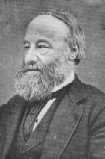 James Prescott Joule (1818 - 1889)
James Prescott Joule (1818 - 1889)
An English physicist who studied the nature of heat and its relationship to
mechanical work. He worked with Lord Kelvin to develop the absolute scale of
temperature, and found the relationship between the flow of current
through a resistance and the resulting heat dissipated - this is now
called "Joule's law". The "joule" which is named after him is a unit
of work with several definitions: The work done, or energy required,
to exert a force of one newton for a distance of one meter. The work
required to move an electric charge of one coulomb through an
electrical potential difference of one volt. The work done to
produce the power of one watt continuously for one second. You may
have noticed that surge suppressors are rated in joules. This is the
amount of surge power (such as from a lightning strike) the device
can absorb without being destroyed. In this case the more joules the
better! |
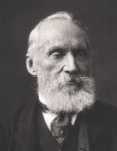 Sir William Thompson a.k.a. Lord Kelvin (1824 - 1907)
Sir William Thompson a.k.a. Lord Kelvin (1824 - 1907)
An Irish-Scottish mathematical physicist and engineer. He did important
work in the mathematical analysis of electricity and thermodynamics, and did
much to unify the emerging discipline of physics in its modern form.
He is best known for an absolute temperature scale, he developed
with James Prescott Joule, called the Kelvin scale. This is a
temperature scale in which zero represents the point at which there
is absolutely no kinetic energy (or heat energy). He was also a
telegraph engineer, and was elected to the board of directors of the
Atlantic Telegraph Company in recognition of work he did to help
with the problem of transmission rate in the Transatlantic telegraph
cable. Thomson had produced a mathematical analysis of the
propagation of electrical signals into telegraph cables based on
their capacitance and resistance. In higher speed data cables,
such as today's Cat 5, it is necessary to factor in inductance as
well. It's interesting to realize that these guys were tackling 100
years ago the same problems we struggle with today. |
 James Clerk Maxwell (1831 - 1879)
James Clerk Maxwell (1831 - 1879)
A Scottish mathematical physicist who developed a set of (4) equations that
express the basic laws of electricity and magnetism. He is believed to be one of
the finest mathematical minds of any theoretical physicist of his
time, and is widely regarded as the nineteenth century scientist who
had the greatest influence on twentieth century physics. He showed
that electric and magnetic fields can travel through the vacuum of
space, in the form of waves, and at a constant velocity of 3.0 × 108
m/s (which is known as the speed of light). He also proposed that
light was a form of electromagnetic radiation. His (4) equations
were based on the previous works of Ampère, Faraday, Gauss, and
others. His first equation, called Ampère's Law, predicts the
magnetic field that will be created by a given flow of current. The
second equation, called Faraday's Law, is essentially the inverse of
the first, and calculates the electrical current that will be
generated from a changing magnetic field (this is how most
electrical power is generated). The third equation, called Gauss'
Law, states that a static electrical charge must generate an
electrical voltage. The fourth equation, simply called the Fourth
Equation, basically asserts that a magnetic charge (or magnetic
monopole) cannot exist - the way that an electron can carry an
electrical charge. It is believed - though may be disproved in the
future - that all magnetic fields have equal and opposing poles. |
 Alexander Graham Bell (1847 - 1922)
Alexander Graham Bell (1847 - 1922)
A Scottish-born scientist and inventor. He is widely believed to be the inventor
of the telephone system, though there were many at the time working on
similar systems. Antonio Meucci and Elisha Gray (the founder of the
Western Electric Manufacturing Company) also made significant
contributions, and can be argued to be inventors of the telephone as
well. While in his twenties, and living in Canada, Bell designed a
piano which could transmit its music electrically. He continued his
research at Boston University and produced a working telephone which
could transmit the human voice as well as musical sounds. On March
7, 1876, the U.S. Patent Office granted him Patent Number 174,465
covering "the method of, and apparatus for, transmitting vocal or
other sounds telegraphically … by causing electrical undulations,
similar in form to the vibrations of the air accompanying the said
vocal or other sound". Bell had many other patented inventions as
well. There were eighteen patents granted in his name alone and
twelve that he shared with his collaborators. These included
fourteen for the telephone and telegraph, four for the photophone,
one for the phonograph, five for aerial vehicles, four for
hydro-airplanes, and two for a selenium cell. The photophone was a
precursor to our modern fiber optic communication system. It enabled
the transmission of sound over a beam of light, and was developed
together with Charles Sumner Tainter. The device employed
light-sensitive cells of crystalline selenium, which have the
property that its electrical resistance varies inversely with the
intensity of illumination. The beam of light was modulated through
the use of a vibrating mirror or rotating disk. Today we use an
electronically modulated solid-state laser, and send the beam
through glass fiber optic cables rather than line-of-sight through
the air. Otherwise the principle is the same as what we use now.
Bell is also credited with the invention of the metal detector in
1881. The device was hurriedly put together in an attempt to find
the bullet in the body of U.S. President James Garfield after his
attempted assassination. |
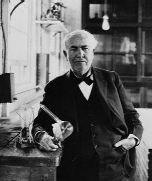 Thomas A. Edison (1847 - 1931)
Thomas A. Edison (1847 - 1931)
Holding 1,097 U.S. patents in his name, Thomas Edison is considered one of the
most prolific inventors in history. He can be credited with the creation of the
first industrial research laboratory, and was dubbed "The Wizard of
Menlo Park" by a newspaper reporter - reflecting the amazement of
many who witnessed his seemingly "magical" inventions. Some of
Edison's most notable inventions are the stock ticker, phonograph,
motion picture camera, and the kinetoscope (a forerunner of the
modern movie projector), but his largest achievement was the
development of the incandescent lighting system. The original idea
for an incandescent lamp was not his, however he worked with
incredible persistence to overcome the technical obstacles and
produced the first usable system that could be sold to the public.
The issue was finding a filament for the lamp that could be
electrically heated to incandescence without self-destructing from
the heat and oxidation. His first success came through the use of a
wire made of carbon operating inside of a glass bulb that had been
evacuated of air. This "burned" for only a few hours, but further
refinements extended the useful life of the lamp to something that
was practical for use by the general public. Building on the success
of this, he and his team went on to design a complete system to
include centrally located DC generators, underground cabling to his
customers, electric metering devices so he could "charge" his
customers, and lamp sockets that allowed for the bulbs to be
replaced after failure. Having excellent business savvy, he chose
Wall Street, New York as the location for his pilot project -
knowing that he needed to impress the investors in order to realize
his dream. With investment capital from J. P. Morgan he built the
Edison General Electric Company - later to become General Electric.
At this same time an inventor named Nikola Tesla (one of Edison's
former assistants) was working with businessman George Westinghouse
to design and build a competing electrical system that was based on
the use of alternating current instead of direct current. This
competition developed into was is known as the great "battle of the
currents". Alternating current has the advantage that it can be
transformed to very high voltages, allowing it to be transmitted for
much greater distances than direct current. Mainly for this reason
alternating current eventually won the battle, and continues to be
what is used today. Probably due mostly to stubbornness Edison
refused to embrace this new technology, and eventually got out of
the electrical business. He continued to be a great inventor,
however, and inspired many to persist and invent right up to his
death. One of his most famous quotes is; "Success is 1 percent
inspiration and 99 percent perspiration". |
 Nikola Tesla (1856 - 1943)
Nikola Tesla (1856 - 1943)
A Serbian born inventor, physicist, and mechanical & electrical engineer.
Tesla is one of the most important and fascinating inventors in the field of
electricity. After studying electrical engineering he worked with
telegraph and telephone designs, and conceived the idea of a
brushless induction motor. In 1884 he moved to the United States and
was hired by Thomas Edison to work at his Edison Machine Works
company. His duties there involved problem solving and improving on
DC generator designs. He left over a disagreement with Edison and
started his own company called the Tesla Electric Light &
Manufacturing Company. The company designed and sold arc lighting
systems, but a difference of opinion with investors over plans to
build an alternating current motor caused him to be relieved of his
duties there. After this, Tesla constructed the initial brushless
alternating current induction motor, which he demonstrated to the
American Institute of Electrical Engineers (now IEEE) in 1888. In
the same year, he developed the principles of his Tesla coil and
began working with George Westinghouse at the Westinghouse Electric
& Manufacturing Company's Pittsburgh labs. Unlike many others,
Westinghouse was open to Tesla's ideas for a complete polyphase
alternating current electrical system, and gave him the backing he
needed to realize this dream. This was in direct competition with
Edison's direct current system, and led to the great "battle of the
currents". Tesla's alternating current system had the advantage that
it can be transformed to very high voltages, allowing it to be
transmitted for much greater distances than direct current. It also
allowed for the use of his brushless induction motors, which require
much less maintenance because of the elimination of the brushes and
commutator of a DC motor. In April of 1887, Tesla began
investigating what would later be called X-rays using his own single
node vacuum tubes, and made many discoveries which helped advance
this science. After this he began to investigate high frequency
alternating currents, and generated AC of one million volts using a
conical Tesla coil. At this time his interests became directed
towards the wireless transmission of electrical signals and energy.
He designed and demonstrated cordless gas discharge lamps,
transmitted electromagnetic energy without wires, and effectively
built the first radio transmitter. When Tesla was 41 years old, he
filed the first basic radio patent (U.S. Patent 645576), and a year
later demonstrated a radio controlled boat to the US military. In
1899 Tesla decided to move to Colorado Springs, Colorado, and built
a laboratory where he would have room for his high-voltage,
high-frequency experiments. Here he experimented with wireless
telegraphy, the ionosphere, the earth's telluric currents,
artificial lightning, and even listened for extraterrestrial radio
signals. After the Colorado Springs experiments, Tesla moved to
Shoreham, Long Island, and built a facility known as the Wardenclyffe Tower.
This tower was 187 feet in height, 68 feet in diameter, and had a
domed cupola at the top that weighed 55 tons. Its purpose
was to demonstrate the ability to send and receive information and
electrical power on a large scale without interconnecting wires.
This idea was way ahead of its time, and the facility could not
become fully operational due to lack of investment capital.
Unfortunately, Tesla suffered increasingly from obsessive-compulsive
disorder as he grew older, and died poor and unrewarded for his
genius. It's interesting to note that one of the newest lamp
types on the market today, the induction lamp, is very similar to
what Tesla designed and demonstrated at the 1893 World's Fair. |
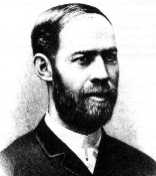 Heinrich Hertz (1857 - 1894)
Heinrich Hertz (1857 - 1894)
A German physicist and scientist. He was the first to demonstrate the existence
of electromagnetic radiation by building an apparatus to produce UHF
(ultra high frequency) radio waves. Hertz helped establish the
photoelectric effect (which was later explained by others) when he
noticed that a charged object loses its charge more readily when
illuminated by ultraviolet light. He began experimenting with the
transmission and reception of electromagnetic waves using a spark
gap transmitter, and did much to explore the propagation and
behavior of these waves both through the air and through different
types of materials. He also developed the dipole antenna to transmit
these radio waves. The hertz, or Hz., is named after him, and is a
unit of electrical and electromagnetic frequency. Unlike Marconi,
Hertz had little vision or understanding for the practical use of
these radio waves. He once stated; "It's of no use
whatsoever[...]" when speaking of his discoveries. These
discoveries would later be more fully understood and exploited
however, by others and become part of the new "wireless age". |
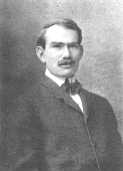 Lee de Forest (1873 - 1961)
Lee de Forest (1873 - 1961)
An inventor credited with over 300 patents, his best known and most significant
invention was the audion vacuum tube. This was a device that could take a weak
electrical signal, such as a radio signal, and amplify it to a more
useful level - such as to drive headphones or a loudspeaker. It
built upon an earlier device called the Fleming Valve by adding a
third electrode called a "grid" to control the amplification of the
signal. The device was sold to the Federal Telegraph Company in Palo
Alto where it was used to amplify telephone signals sent through
transcontinental cables, and was further improved to work as an
oscillator in the radiotelephone - an early invention to transmit
voice and entertainment into households. In 1907 he formed the De
Forest Radio Telephone Company for this purpose, and it became one
of the early radio broadcast companies from which this industry
grew. In 1919, De Forest filed his first patent on a sound-on-film
process, which improved on the work of German inventors, and called
it the De Forest Phonofilm process. It recorded sound directly onto
film as parallel lines. These lines photographically recorded
electrical signals from a microphone, which were translated back
into sound waves when the movie was projected. He was given an
Academy Award (Oscar) in 1959/1960 in recognition for this work. |
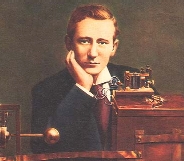 Guglielmo Marconi (1874 - 1937)
Guglielmo Marconi (1874 - 1937)
An Italian electrical engineer known for the development of a practical wireless
telegraphy system commonly known as the "radio". Although many
scientists and inventors contributed to the invention of wireless
telegraphy, Marconi's system achieved widespread use, and therefore
he is often thought of as the "father of radio". Marconi did use
others' patents in the development of his system, such as Karl
Ferdinand Braun's tuning system. He also demonstrated a variety of
Tesla's radio frequency systems during lectures to the National
Electric Light Association in St. Louis, and the Franklin Institute
in Philadelphia. This should not distract from his achievements
though, since few inventions are entirely original. Most all
scientists and inventors build on and improve the discoveries of
their predecessors. Marconi demonstrated the transmission and
reception of Morse Code based radio signals over a distance of 2 or
more kilometers on Salisbury Plain in England in 1896. For this he
was awarded a patent for Radio communications with British Patent
GB12039 - sometimes recognized as the World's first patent in radio
telecommunication. In July of 1897 Marconi formed the London based
Wireless Telegraph Trading Signal Company (later renamed the Marconi
Wireless Telegraph Company), which opened the World's first
"wireless" factory in Hall Street, Chelmsford, England. In 1901
Marconi built a station near Wellfleet, Massachusetts. It was first
called CC (Cape Cod), then MCC (Marconi Cape Cod) and finally WCC
when the US government issued "W" call letters to stations east of
the Mississippi. In 1903, from this station, Marconi sent a famous
message from the President of the US to the King of the United
Kingdom without having to be relayed. In 1914, Marconi built WCC in
Chatham, Massachusetts, on Cape Cod, and it would become the busiest
ship to shore radio station for most of the twentieth century. WCC
was sold during the breakup of RCA in the 1990s to MCI, and was
finally shut down in 1997. |
 Philo Farnsworth (1906 - 1971)
Philo Farnsworth (1906 - 1971)
At age 14 he worked out the details for an advanced electron tube called an
"image dissector", and demonstrated a working unit in 1927. By 1929
he had further improved the tube and transmitted the first human images
(including one of his wife) to a receiver which used a cathode ray tube to
display the images. In 1930 an employee of RCA named Vladimir
Zworykin visited Farnsworth's laboratory, was impressed with his
image tube technology, and went back to RCA where he made additional
advancements to it, allowing it to capture a sharper image with less
light on the subject. The combination of these developments resulted
in the Image Orthicon tube which was used in television cameras
until the 1960's. In the late 1960's Farnsworth designed an
apparatus called the Farnsworth-Hirsch Fusor to create nuclear
fusion. This invention came about from earlier research he did in
developing cathode ray tubes for his TV receiver. The apparatus
injects "high temperature" ions directly into a reaction chamber in
order to produce a fusion reaction. Initially there was hope that it
could be used to generate power, but insolvable technical problems
prevented it from achieving a net gain of energy. It was successful
however, as a neutron generator, and continues to be used for this today. |
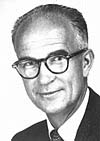 William Shockley (1910 - 1989)
William Shockley (1910 - 1989)
A British-born American physicist and co-inventor of the transistor (with
John Bardeen and Walter Houser Brattain) for which he was awarded the Nobel
Prize in physics. The three had been working together on theories of electric
field effects in solid state materials, with the goal of replacing
the triode vacuum tube which was large, fragile, and consumed much
power. It was actually Bardeen and Brattain who worked out the final
details and constructed the working prototype, but Shockley received
a share in the credit since the team had been motivated by
Shockley's idea of using field effects. At the same time he secretly
continued his own work to build a different sort of transistor based
on junctions instead of point contacts, expecting this kind of
design would be more commercially viable. He was able to work out
the technical problems involved, and obtained a patent for the the
junction transistor on July 5, 1951. Eventually he was appointed as
the Director of Shockley Semiconductor Laboratory in Mountain View,
California, a division of Beckman Instruments. He had a hard time
recruiting the people he wanted due to his difficult personality,
but his efforts to commercialize this new transistor design during the
1950s and 60s led directly to the creation of Silicon Valley. |
 Jack Kilby (1923 - 2005)
Jack Kilby (1923 - 2005)
A notable American electrical engineer who co-won the Nobel Prize in physics
in 2000. He invented the integrated circuit in 1958 while working at Texas
Instruments, about six months before Robert Noyce made the same
invention at Fairchild Semiconductor. In 1938 Kilby rode with his
father to the home of a neighbor and ham radio operator during a
blizzard in Great Bend, Kansas. He was so fascinated by the
equipment that he claimed; "It convinced me that I wanted to study
electrical engineering." He received his bachelor of science degree
from the University of Illinois at Urbana-Champaign in 1947, with a
degree in Electrical Engineering, and obtained a master's degree
from the University of Wisconsin in 1950. In the summer of 1958,
Kilby was employed as an engineer at Texas Instruments, and spent
the summer working on a problem in circuit design that was commonly
called the "tyranny of numbers". This was a problem, mainly with
computing devices, where the number of necessary components grew
increasingly larger, making it increasingly more difficult to
connect them together using common wiring methods. He realized that
the solution was to manufacture large numbers of these components on
a single substrate. He presented his findings to the management of
Texas Instruments, and showed them a piece of germanium with an
oscilloscope attached. He pressed a switch and the oscilloscope
showed a continuous sine wave, proving that his integrated circuit
worked and that he had solved the problem. A patent for a "Solid
Circuit made of Germanium" was filed on February 6, 1959 - the first
integrated circuit. In addition to the integrated circuit, Jack
Kilby is also known for helping to develop the portable electronic
calculator, and later in his career, worked on thermal printing and
solar panels. |
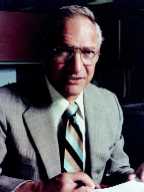 Robert Noyce (1927 - 1990)
Robert Noyce (1927 - 1990)
He co-founded Fairchild Semiconductor in 1957 and Intel in 1968. He is
also credited (along with Jack Kilby) with the invention of the integrated
circuit or microchip although Kilby's invention was 6 months earlier. After
graduating from MIT in 1948 he went to work for an electronics
company named Philco making transistors. He left there to work for
William Shockley's company, Shockley Semiconductor. Disagreements
with Shockley caused Noyce and seven other young researchers to
leave and found Fairchild Semiconductor. While there he developed an
integrated circuit similar to Jack Kilby's invention. He left in
1968 with Gordon Moore and co-founded Intel. While at Intel he
oversaw Ted Hoff's invention of the microprocessor, which was the
integration of not just many transistors, but most of the main
circuits of a modern computing device. His casual style gave
coworkers and employees the freedom to develop the technology based
on their talents, and in many ways defined the Silicon Valley
working style. |
 Gordon Moore (born 1929)
Gordon Moore (born 1929)
The cofounder of Intel Corporation and the author of Moore's law (published
in an article in Electronics Magazine, dated April 19, 1965). This "law"
observes that integrated circuit complexity doubles approximately every 2
years. After acquiring a Ph.D. in Chemistry and Physics from the
California Institute of Technology (Caltech) in 1954, he went to
work at Shockley Semiconductor. He left there along with Robert
Noyce and others to create Fairchild Semiconductor. He co-founded
Intel Corporation in July of 1968 with Robert Noyce, and became
President and Chief Executive Officer of the company in 1975. In
1979 he became Chairman and Chief Executive Officer, and remained as
CEO until 1987. He is currently a director of Gilead Sciences Inc.,
a member of the National Academy of Engineering, and a Fellow of the
IEEE (Institute of Electrical and Electronics Engineers). Moore also
serves on the Board of Trustees of the California Institute of Technology. |

